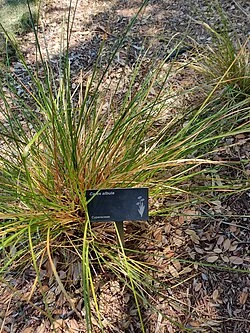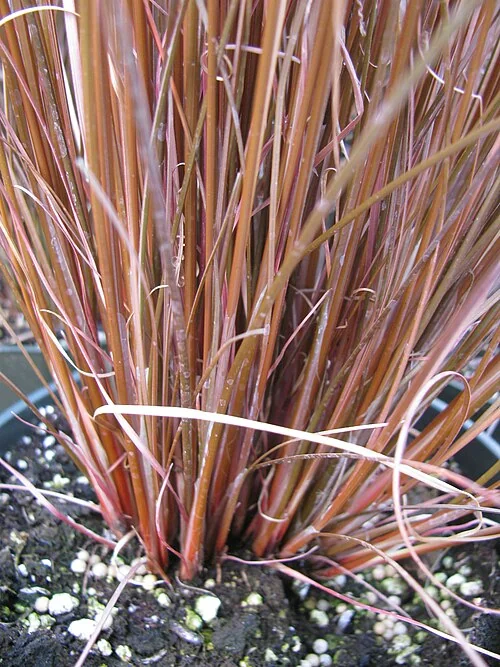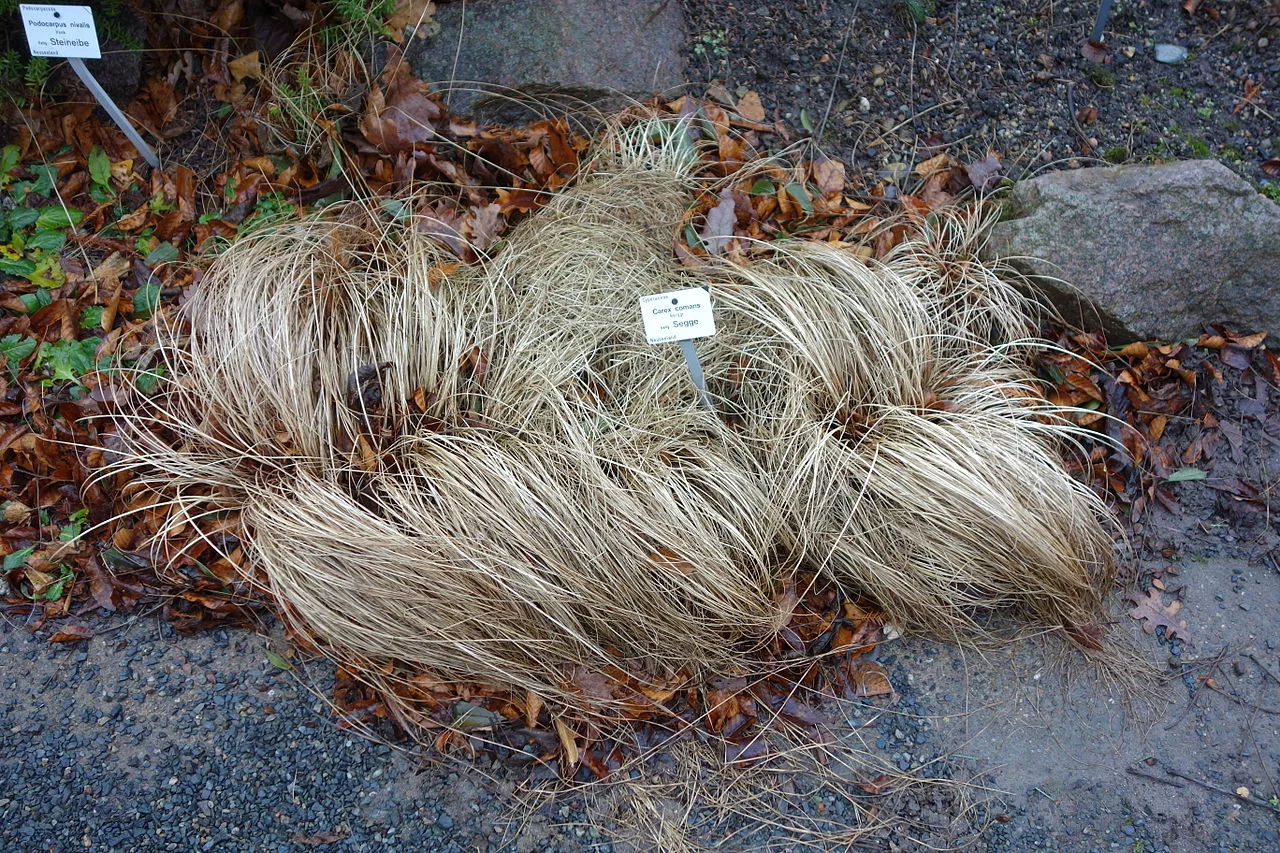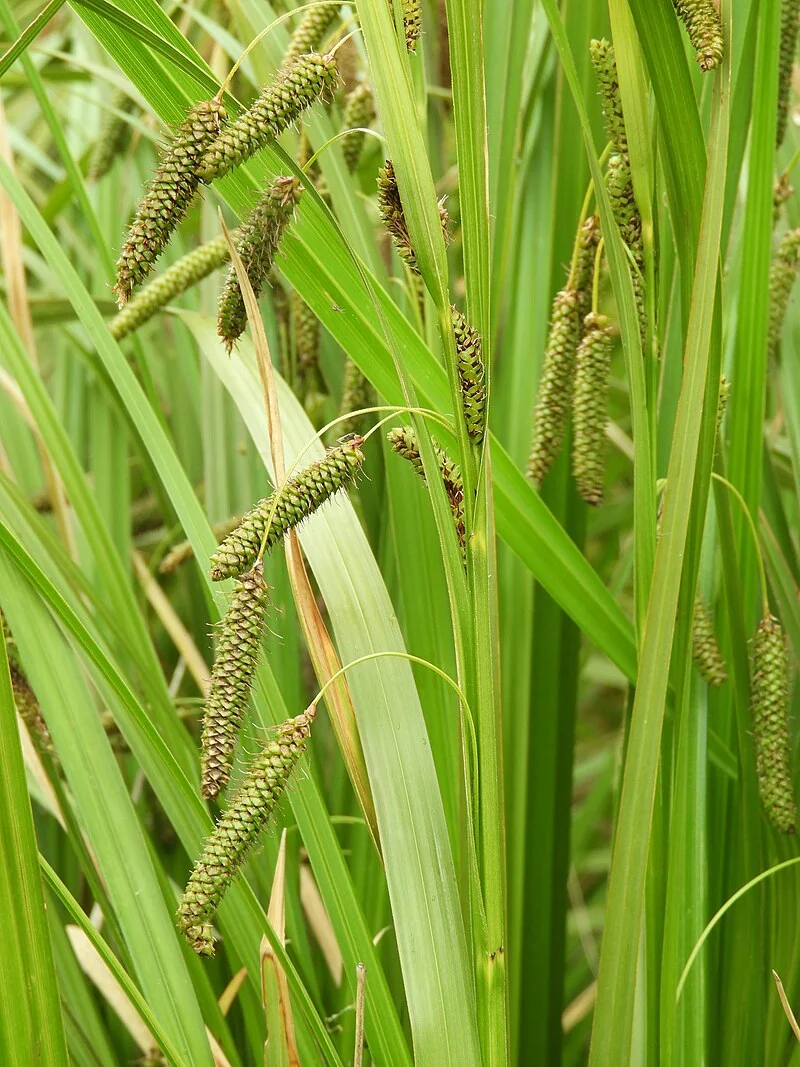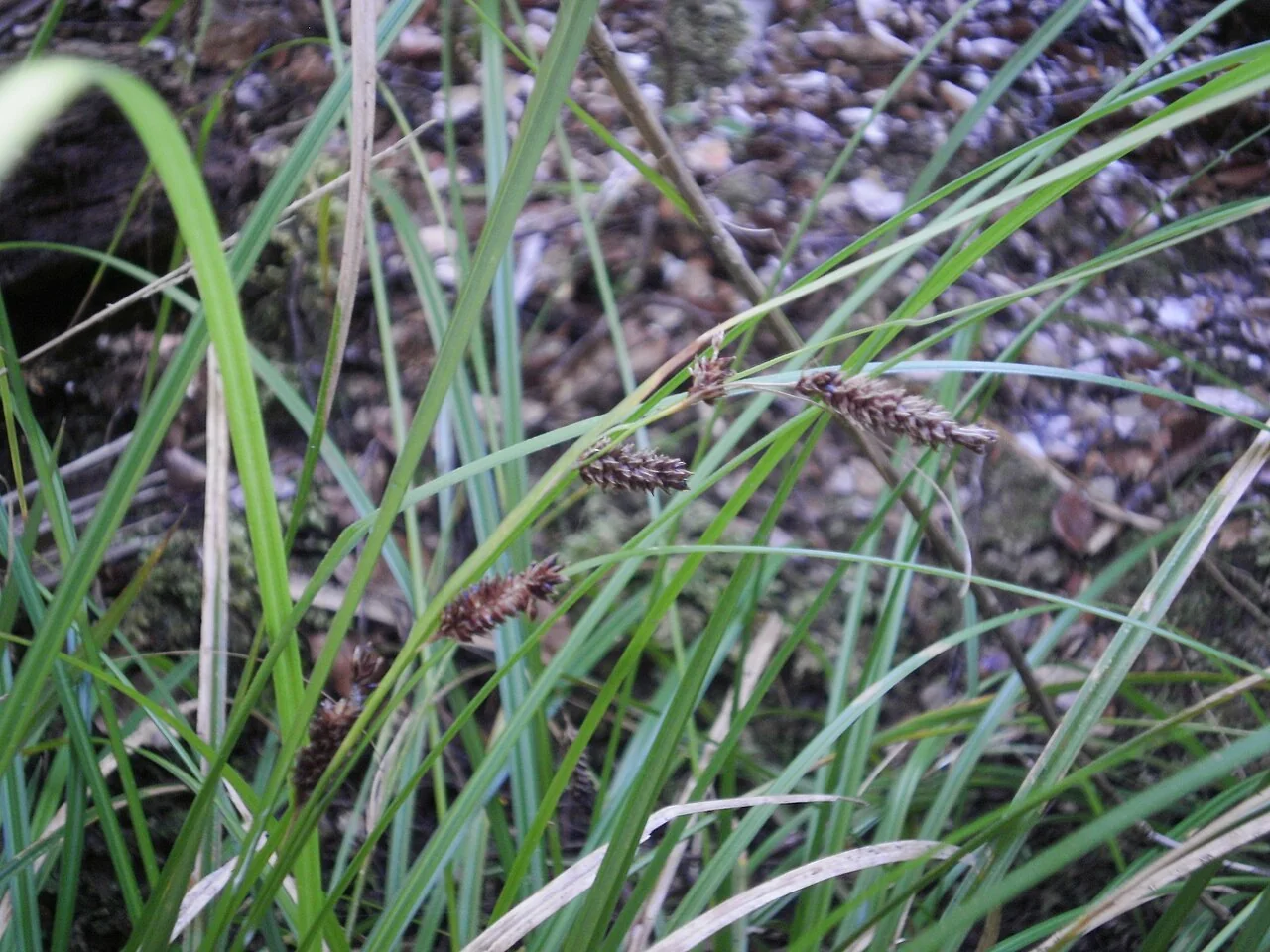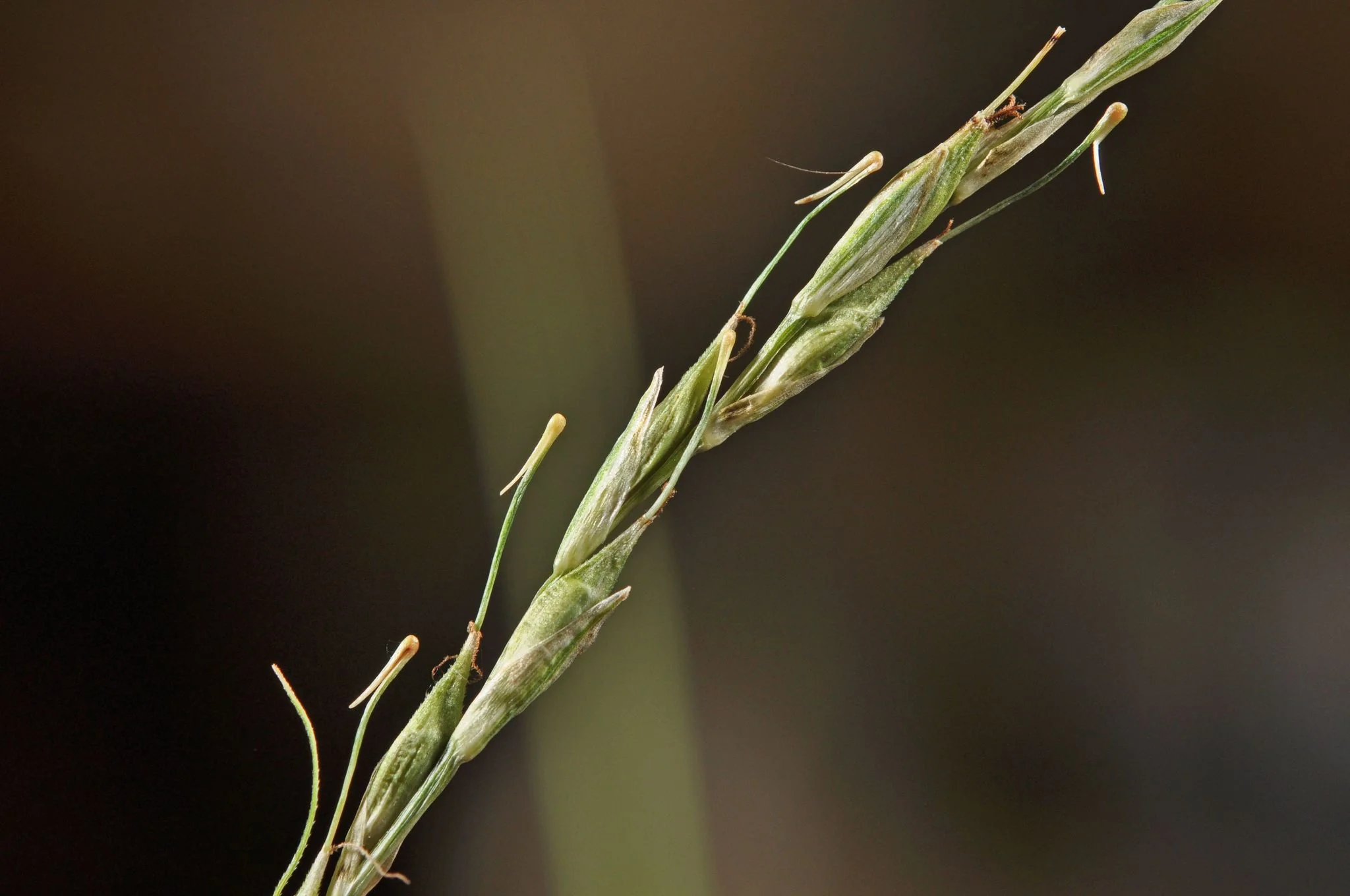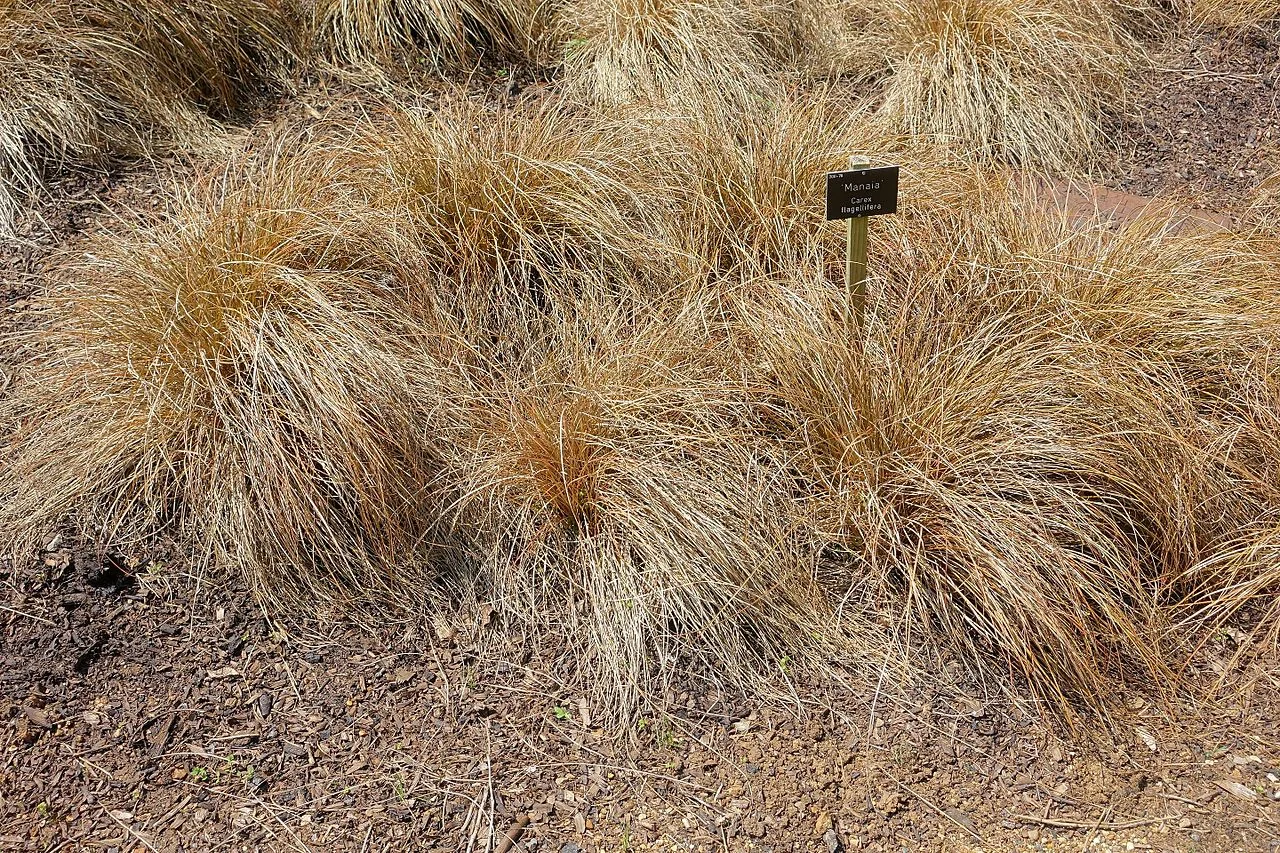
Glen Murray Tussock
Carex flagellifera
Explore more NZ native plant guides in our index .
Introduction
About Glen Murray Tussock
Carex flagellifera , commonly known as Glen Murray Tussock or Trip Me Up, is a remarkable endemic sedge found throughout New Zealand's North, South, Stewart, and Chatham Islands, distinguished by its unique whip-like trailing behavior that gives it both its scientific and common names. The species epithet "flagellifera" derives from Latin "flagrum" (whip) and "ferre" (to bear), perfectly describing its characteristic long fruiting culms that initially grow erect to 35-75cm before becoming prostrate and trailing across the ground in spectacular cascading displays. This densely tufted sedge develops narrow, channeled leaves 1.5-2.5mm wide with distinctively scabrous (rough) margins, available in both green and bronze ornamental forms that create stunning textural contrasts. Its exceptional adaptability from coastal to montane environments, combined with its dramatic architectural form and ease of cultivation, makes this variable species highly prized for contemporary landscape design and specialty horticultural applications.

Plant Description
Carex flagellifera , commonly known as Glen Murray Tussock or Trip Me Up, is a distinctive evergreen sedge native to New Zealand. It forms dense, wiry clumps of narrow, hair-like foliage that can range in colour from dark green to coppery-bronze or reddish-brown. Its most unique feature is its long, whip-like fruiting culms that initially grow erect but then become prostrate and trail elegantly across the ground, sometimes reaching up to 2.8 meters in length. This cascading habit gives the plant its common name and makes it a popular ornamental grass for landscape design.
Quick Facts
Tussock Summary
| Scientific Name | Carex Flagellifera |
|---|---|
| Height | 30-70 cm |
| Spread | 30-60 cm |
| Water Needs | Moderate; prefers consistently moist soil |
| Light | Full sun to partial shade |
| Frost Tolerance | High |
| Salt Tolerance | Moderate |
| Growth Rate | Moderate |
| Lifespan | Perennial |
Climate Best Suited to
Carex flagellifera demonstrates remarkable ecological versatility across New Zealand's diverse landscape zones, naturally occurring from coastal environments to montane regions where it establishes in free-draining soils under scrub or open forest conditions. This hardy endemic sedge thrives across New Zealand's temperate maritime climate, adapting to varied moisture conditions while preferring sunny positions with reasonable moisture levels. Its natural distribution spanning four major island groups reflects its tolerance for different climatic conditions, from the warmer, humid northern regions to the cooler, more variable southern climates, making it an exceptionally reliable choice for diverse garden situations throughout New Zealand.
Regional Suitability
| Whangārei | Ideal |
| Auckland | Ideal |
| Hamilton | Suitable |
| Rotorua | Suitable |
| Tauranga | Ideal |
| Gisborne | Ideal |
| New Plymouth | Ideal |
| Whanganui | Ideal |
| Palmerston North | Suitable |
| Napier | Ideal |
| Wellington | Ideal |
| Nelson | Ideal |
| Christchurch | Suitable |
| Dunedin | Suitable |
| Invercargill | Suitable |
| City | Climate Suitability |
|---|
Habitat
Natural Distribution
Carex flagellifera , commonly known as Glen Murray Tussock or Trip Me Up, is an endemic sedge found throughout New Zealand's North, South, Stewart, and Chatham Islands. It is native to New Zealand, Tasmania, and the Chatham Islands, and is found in a variety of habitats, ranging from coastal areas to montane regions.
This sedge typically grows in free-draining soils under scrub or open forest conditions. While it can tolerate a wide range of conditions, it rarely occurs in wetlands or permanently damp, shaded sites. It thrives in full sun to partial shade and can grow in both exposed and sheltered locations. Carex flagellifera is also noted for its suitability to coastal and temperate conditions, demonstrating its adaptability to diverse environments.
Plant Conservation
Carex flagellifera is an endemic New Zealand sedge with populations across North, South, Stewart, and Chatham Islands, extending also to Tasmania. The species has undergone assessment under the New Zealand Threat Classification System as part of the comprehensive 2022-2023 review of all known New Zealand vascular plant taxa.
The species benefits from its wide distribution and adaptability to diverse habitats ranging from coastal areas to montane regions. Its ability to thrive in free-draining soils under scrub or open forest conditions, combined with tolerance for both full sun and partial shade, contributes to its ecological resilience across varied environmental conditions.
As a culturally significant plant known to Māori as mānia, particularly important to Ngāi Tahu for traditional bedding and practical applications, the species holds value beyond its ecological role. This cultural connection helps maintain awareness and appreciation of indigenous flora, supporting conservation efforts through traditional knowledge preservation.
The species' popularity in cultivation and landscaping provides conservation benefits through reduced pressure on wild populations while maintaining genetic diversity in managed settings. Its widespread cultivation in gardens, particularly for erosion control and as an ornamental tussock grass, demonstrates successful adaptation to human-modified environments while preserving the species' genetic heritage.
Growing Requirements
Soil Requirements
White maire (Nestegis lanceolata) is remarkably adaptable to different soil conditions, thriving in well-drained environments. It can tolerate a variety of soil types, from sandy to loamy, and prefers a neutral to slightly acidic pH. Good drainage is crucial to prevent root rot, ensuring healthy growth and development.
- Tolerates a wide range of soil types from clay to sandy
- Prefers well-draining soils but can handle occasional waterlogging
- Thrives in moderately fertile soils but will grow in poor soils too
- Can tolerate slightly acidic to slightly alkaline pH
- Handles coastal conditions including salt spray
Light Requirements
White maire (Nestegis lanceolata) thrives in a variety of light conditions, from full sun to partial shade. Optimal growth and flowering are typically achieved in locations receiving ample sunlight throughout the day. However, it can also tolerate some shade, especially in hotter climates, where it benefits from protection during the most intense afternoon sun.
- Full sun for optimal growth and form
- Can tolerate partial shade but may develop a leggier form
- At least 6 hours of direct sunlight daily is ideal
- Northern or eastern exposures work well in garden settings
Water Requirements
Once established, White maire (Nestegis lanceolata) is remarkably drought-tolerant, requiring minimal supplemental watering. During its establishment phase, consistent moisture is crucial to encourage strong root development. Mature plants can withstand dry periods, but regular watering during prolonged droughts will promote healthier growth and more abundant flowering.
- Moderate watering during establishment (first 1-2 years)
- Drought-tolerant once established
- Can handle periods of soil saturation
- Reduce watering in winter when growth slows
- Signs of overwatering include yellowing leaves and crown rot
Planting Guide
-
When to Plant
Plant in autumn or spring.
-
Site Preparation
Choose a sunny or partially shaded site with moist, well-drained soil.
-
Planting and Aftercare
Dig a hole twice the width of the pot. Place the plant in the hole and backfill with soil. Water well and apply a layer of mulch.
Ecological Significance
Carex flagellifera , also known as Glen Murray Tussock or Trip Me Up, is a species of sedge native to New Zealand, Tasmania, and the Chatham Islands. It plays several ecological roles within its native habitats, contributing to ecosystem health and biodiversity.
- Habitat and Distribution: Carex flagellifera is typically found in free-draining soils under scrub, tall forest, or in open vegetation, ranging from coastal to montane areas. It is less common in wetlands or consistently damp, shaded environments, indicating its preference for drier, more open conditions.
- Soil Health and Stability: As with other Carex species, Carex flagellifera likely contributes to soil stabilization and erosion control through its extensive, fibrous root system. These roots improve soil aeration and drainage by creating channels and pores, and they release nutrients and organic matter as they decompose, supporting microbial communities.
- Food Web Contribution: Sedges are vital components of food webs, offering food sources such as protein-rich seeds and fibrous foliage for various wildlife, including herbivores, insects, and small mammals. Its foliage is attractive to insects, further supporting local biodiversity.
- Ecosystem Engineering: Carex species are considered ecosystem engineers, aiding in nutrient cycling by converting organic matter into forms usable by other organisms. They also create complex habitat structures that support diverse foraging behaviors.
- Seed Dispersal: The nuts (seeds) of Carex flagellifera are dispersed through granivory (consumption and dispersal by animals) and wind, facilitating its spread and regeneration in suitable habitats.
- Biodiversity: Sedges are often recognized as keystone species, underscoring their importance for maintaining biodiversity within their ecosystems.
While generally beneficial, Carex flagellifera can also be considered a significant weed in pastures within its native New Zealand and an environmental weed in Tasmania, where it can invade grasslands and woodlands, highlighting the need for careful management in certain contexts.
Uses and Significance
Garden Uses
- Specimen tree for visual impact
- Suitable for native gardens and restoration projects
- Enhances native garden aesthetics and biodiversity
- Provides architectural accent with its unique structure
- Effective for erosion control on slopes and banks
Ecological Value
Ecologically, White maire (Nestegis lanceolata) plays a crucial role in supporting native ecosystems. Its fruits are a food source for birds, especially the kererū, contributing to the local biodiversity and food web.
- Provides a vital food source for native birds, especially the kererū
- Offers habitat and nesting sites for various fauna
- Contributes to soil stabilization and nutrient cycling
- Forms natural shelter belts, protecting other species
Cultural Significance
Traditional Uses and Values
While not as widely documented for traditional Māori uses as some other native plants, Glen Murray Tussock ( Carex flagellifera ) was part of the unique high-country landscape and would have been known to local iwi. Its distinctive appearance would have made it a recognizable feature of the dry interior regions of the South Island.
Landscaping Uses
Garden Design Applications
Carex flagellifera , also known as Glen Murray Tussock or Trip Me Up, is a versatile ornamental grass highly valued in landscaping for its fine-textured, arching foliage that ranges in colour from shiny green to bronze and brownish shades. It typically grows to 50-70 cm tall and wide, forming attractive, fountain-like clumps, making it suitable for a variety of garden designs.
- Mass Plantings: It is excellent for creating a natural grassland effect in beds and borders, or as a groundcover on banks. Its ability to spread and form dense clumps makes it ideal for covering larger areas.
- Containers: Ideal for pots and containers, either alone or in mixed arrangements, where its arching leaves and distinctive trailing culms can cascade gracefully over the edges, adding a unique character to patios and balconies.
- Edging and Rock Gardens: Its tidy form and ability to complement hardscaping make it work well as path edging and tucked between rocks in rockeries, softening the edges and adding texture.
- Accent Plant: It serves as a graceful accent plant, mixing beautifully with flowering bulbs or perennial plants, providing a subtle yet striking contrast with its unique foliage colour and form.
- Around Trees: Often planted at the base of larger trees, it can create a natural underplanting that enhances the overall aesthetic of a woodland garden.
- Low-Maintenance Areas: Suitable for city, courtyard, and commercial gardens due to its low maintenance requirements and resilience to various conditions.
- Coastal Gardens: Tolerant of coastal conditions, including wind and salt spray, making it a good choice for seaside landscapes.
- Outdoor Living Areas: Can be used around patios, ponds, pool areas, and other outdoor living spaces to add a natural and calming element.
Seasonal Care Calendar
Spring
In spring, White maire (Nestegis lanceolata) begins its active growth phase. New foliage emerges, and it's an ideal time for planting new specimens or propagating. Ensure adequate moisture and monitor for early signs of pests.
- New growth begins with fresh foliage development
- Apply a balanced, slow-release fertilizer if desired
- Excellent time for planting new specimens or dividing offsets
- Monitor for new pest activity and address promptly
Summer
Summer is the peak growing season for White maire (Nestegis lanceolata), often accompanied by flowering. Consistent watering is important, especially for young plants, to support vigorous growth and prevent stress during dry periods.
- Flowering typically occurs in early to mid-summer (November-January)
- Water young trees regularly during extended dry periods
- Avoid heavy pruning during the active growing season
Autumn
During autumn, White maire (Nestegis lanceolata) prepares for the cooler months. Fruits or berries develop, providing food for native birds. It's also a good time for planting and general garden cleanup.
- Fruits or berries develop and ripen (December-February), attracting birds
- Natural leaf shedding occurs as part of its growth cycle
- Good time for planting new specimens to establish before winter
- Clean up fallen leaves if a tidy appearance is desired
Winter
Winter is generally a dormant period for White maire (Nestegis lanceolata). Minimal care is required, though young plants may benefit from protection in colder regions. This is an opportune time for any necessary structural pruning.
- Generally dormant with minimal growth activity
- No special winter protection needed in most mild climates
- Suitable time for structural pruning if required
- Fallen leaves can be left as mulch or removed for tidiness
When to Prune and How Much
White maire (Nestegis lanceolata) generally requires minimal pruning to maintain its natural form and health. Pruning should focus on removing dead or damaged growth and shaping the plant as needed.
- Remove dead, damaged, or diseased branches at any time of year
- Light formative pruning when young helps establish good structure
- To create a multi-trunked specimen, cut the main stem to encourage branching
- Fallen leaves can be removed for a tidier appearance, or left as natural mulch
- If necessary, lower branches can be removed to create clearance underneath
- Major pruning is best done in late winter to early spring before new growth
Always use clean, sharp tools for pruning to minimize the risk of disease and ensure clean cuts. The plant often responds well to pruning with vigorous new growth, contributing to a fuller, healthier appearance.
How to Grow Glen Murray Tussock
From Division
Division represents the most efficient and reliable propagation method for Glen Murray Tussock, taking advantage of this distinctive ornamental sedge's natural clumping growth habit and exceptional ease of establishment to create multiple plants with identical characteristics. This variable species forms densely tufted clumps through fibrous root systems, making it exceptionally straightforward to divide into independent plants for landscape use or horticultural selection purposes. The variable nature of this species makes division particularly valuable for preserving superior forms with attractive trailing characteristics, distinctive colour variations, or other desirable ornamental qualities that can be maintained through vegetative propagation. The optimal timing for division is during spring or autumn when the plant is either emerging from or entering dormancy, providing divided sections with favorable conditions for rapid root establishment before facing environmental stress. Begin by carefully lifting entire clumps using a garden fork, working gently around the perimeter to preserve the densely tufted root system that provides excellent drought tolerance and rapid establishment once transplanted. Glen Murray Tussock develops a substantial fibrous root mass that is relatively easy to handle during division, though care should be taken to preserve root integrity for optimal establishment success. Once lifted, examine the clump structure to identify natural division points where separate tufts have developed within the larger colony, typically visible as distinct growing centers with their own root systems. The densely tufted nature of this species often creates clear separation points that can be exploited with minimal root damage during the division process. Use clean hands or small tools to separate divisions along natural boundaries, ensuring each section includes both healthy roots and sufficient crown material to support the plant's distinctive growth habit and trailing characteristics. Divisions can be quite small as this species establishes readily, with even modest sections containing 2-3 growing points capable of developing into substantial clumps within one growing season. Each division should include adequate root mass and multiple growing points to ensure successful establishment and rapid development of the trailing culms that make this species so distinctive in ornamental plantings. Replant divisions immediately at the same depth they were previously growing, spacing them according to desired coverage and the specific landscape goals for the planting area. Choose locations with well-draining soil and full sun to partial shade, as this adaptable species thrives in a wide range of conditions once properly established. Water thoroughly after planting to settle soil around roots, then maintain moderate moisture during establishment while avoiding waterlogged conditions that can inhibit root development in this drought-tolerant species.
From Seeds
Seed propagation provides an excellent method for growing Glen Murray Tussock that allows for natural selection of superior forms while maintaining the genetic diversity that makes this species so variable and interesting for horticultural use. This prolific seeder grows easily from fresh seed, making it accessible for both home gardeners and restoration projects where large numbers of plants are required for natural landscape establishment. The species produces abundant viable seeds on distinctive trailing culms that develop during the fruiting period, providing multiple opportunities for collection throughout the extended season when seeds mature and become available for harvesting. Collect fresh seeds from the trailing culms during their fruiting period when seeds have fully matured but not yet begun to disperse naturally, cutting entire seed heads with clean secateurs and placing them in paper bags to complete drying in a well-ventilated location. Seeds maintain good viability when collected fresh and should be sown immediately in autumn for optimal germination results, as this species responds well to natural winter conditioning that helps break dormancy mechanisms. The natural variability within seed-grown populations offers exciting opportunities to select plants with particularly attractive trailing habits, appealing colour forms, or other desirable characteristics that can then be preserved through division of superior specimens. Prepare well-draining seed-raising mix using standard compost with added perlite or coarse sand to ensure adequate drainage while maintaining consistent moisture levels during germination. Sow seeds thinly on the surface of firm, moist growing medium, covering lightly with a thin layer of fine sand or vermiculite as they benefit from some light during germination while requiring protection from drying out. Place seed trays in a protected location with bright, indirect light and consistent cool temperatures throughout winter, allowing natural stratification to occur as temperatures fluctuate with seasonal changes. Maintain consistent moisture without waterlogging throughout the germination period, which typically occurs during spring as temperatures begin to warm and growing conditions become favorable. Young seedlings develop relatively quickly compared to other sedges, establishing the characteristic tufted growth habit within their first growing season while showing the natural variation that makes this species so valuable for selection work. Seedlings can be transplanted when they have developed sufficient root systems and foliage mass, typically after 6-8 weeks of growth under favorable conditions. This method is particularly valuable for creating diverse plantings where the slight variation in growth habits and colour characteristics adds visual interest to landscape installations.
From Selection and Breeding
Selection and breeding programs offer advanced propagation opportunities for Glen Murray Tussock that take advantage of the species' natural variability to develop superior ornamental forms with enhanced landscape value and specific desired characteristics. This approach is particularly valuable for commercial nursery production and for gardeners interested in developing unique plant materials that showcase the best qualities of this variable New Zealand native species. The natural variation within Glen Murray Tussock populations provides excellent raw material for selection work, with plants showing differences in trailing habit intensity, foliage colour, drought tolerance, and overall ornamental appeal that can be identified and preserved through careful propagation techniques. Begin selection programs by establishing diverse seed-grown populations from multiple parent plants or wild-collected seed sources, allowing natural variation to express itself over several growing seasons under consistent growing conditions. Evaluate plants for desirable characteristics such as particularly attractive trailing culms, distinctive colour variations, compact growth habits, or enhanced drought tolerance that would be valuable in ornamental plantings or challenging landscape situations. Document superior performers through photographs, measurements, and detailed notes about their specific qualities and growing requirements to maintain accurate records for future propagation and development work. Propagate selected superior forms exclusively through division to maintain their exact characteristics, avoiding seed propagation which would introduce genetic variation and potentially dilute the desired traits being preserved. Establish stock plants of selected forms in optimal growing conditions to provide reliable sources of division material for ongoing propagation and distribution to other growers or landscape projects. Test selected forms under various growing conditions to evaluate their adaptability and performance across different soil types, moisture levels, and exposure conditions that they might encounter in commercial or residential landscape installations. Develop naming and documentation systems for superior selections to maintain their identity and provenance throughout the selection and distribution process, ensuring that valuable genetic material is not lost or confused with inferior forms. This advanced approach requires longer time frames and more intensive management than simple propagation methods, but can produce superior plant materials that enhance the ornamental value and landscape utility of this already attractive native species.
Pests and Diseases
Naturally Robust
Generally pest and disease free.
Watch for scale and fungal leaf spots; improve airflow and avoid over-watering to limit disease pressure.
Bonus Tip
Expert Growing Advice
Carex flagellifera , also known as weeping brown sedge or Glen Murray tussock sedge, is a distinctive ornamental grass native to New Zealand and Tasmania. The species epithet "flagellifera" is Latin for "whip-bearing," referring to its very slender, whip-like leaves. Its long, grass-like leaves, which can be various shades of green, yellow-green, bronze, or reddish-brown, curl gracefully towards the ground, creating a delicate, softening effect in the landscape. This sedge is an excellent choice for low-maintenance gardening. It is drought-tolerant, deer and rabbit resistant, and requires very little care once established. It thrives in moist, well-drained soils and can be grown in full sun to partial shade. It also looks great in containers, where its arching foliage can cascade over the sides of the pot.
